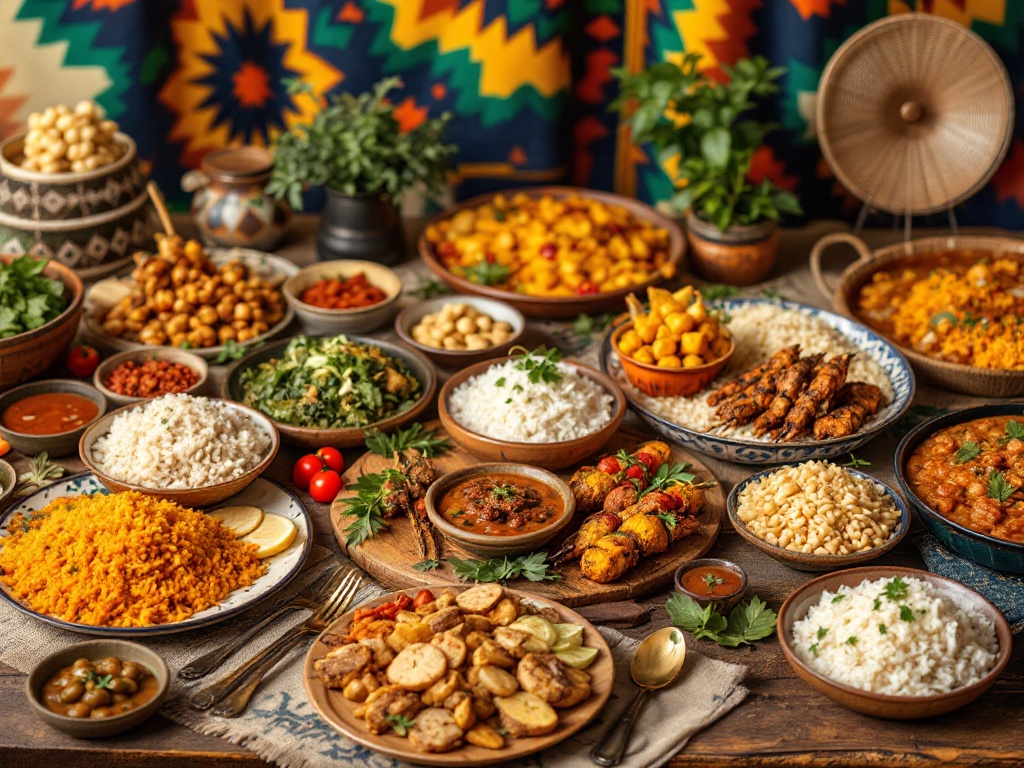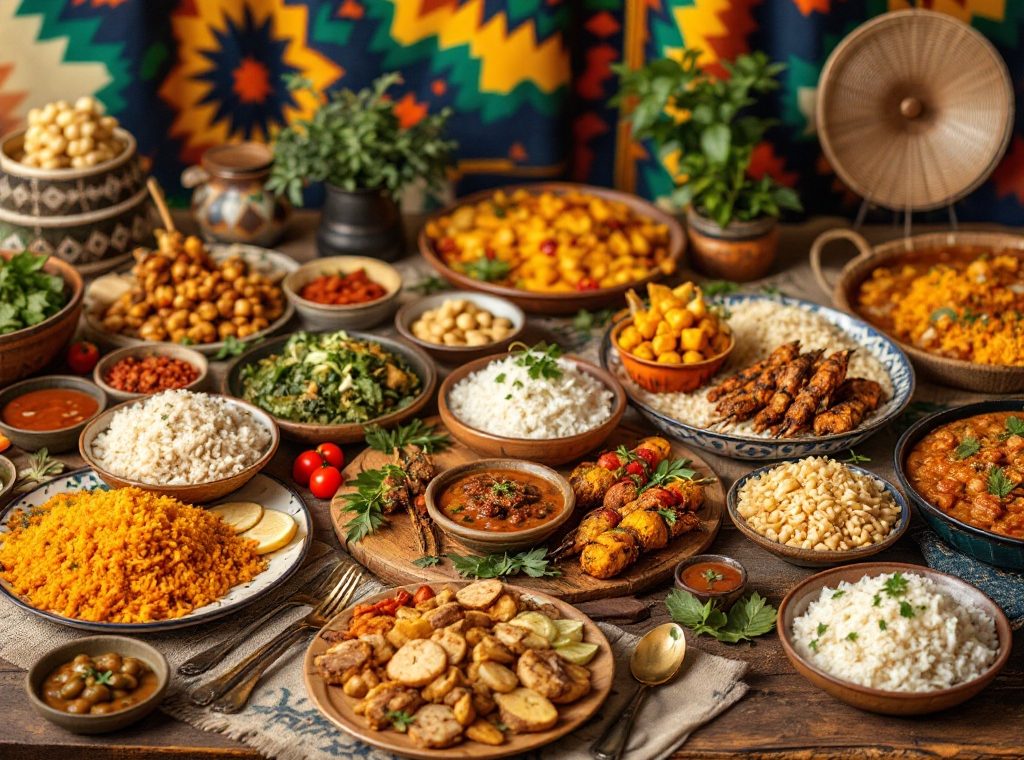What to Eat in Mali: A Guide to the Most Popular Food in Mali
Embark on a culinary adventure to Mali, a land where rich flavors and vibrant traditions intertwine! Discover the heart of Malian cuisine, from staple grains like rice and millet, served with flavorful sauces of spinach, peanuts, and baobab leaves, to hearty stews like Maafe and Tiguadege Na. Explore popular dishes like Jollof Rice and Dibi, and learn about the essential role of fufu. Delve into the unique regional variations and cooking methods that showcase Mali’s diverse culinary heritage. Ready to tantalize your taste buds? Dive into the world of Malian cuisine!
Important information

- Malian cuisine uses grains like rice and millet, served with sauces made from spinach, tomatoes, peanuts, or sweet potato leaves.
- Meat, such as chicken, mutton, beef, and goat, is a key part of many dishes.
- Fufu, a dough made from pounded starchy vegetables, is a staple often eaten with stews and sauces.
- Tiguadege na, the national dish, features chicken in a rich peanut sauce.
- Other popular dishes include Maafe (peanut butter stew), Jollof rice, and Dibi (grilled spiced meat).
Understanding Malian Cuisine and Its Staples
Malian cuisine showcases a variety of grains, such as rice and millet, frequently accompanied by flavorful sauces. These sauces often incorporate ingredients like spinach, sweet potato leaves, tomatoes, or peanuts. Regional variations are widespread, reflecting the country’s diverse agricultural practices and cultural influences. These variations may include unique ingredients or cooking methods, highlighting Mali’s rich culinary heritage. Meat also plays a significant role in Malian dishes, with common options including chicken, mutton, beef, and goat.
The Foundation of Malian Cuisine: Cereal Grains
Malian cuisine features a variety of cereal grains, especially rice and millet. These staples are often accompanied by flavorful sauces made from leafy greens such as spinach, sweet potato leaves, or the unique baobab leaf. Tomato and peanut sauces are also popular choices. Grilled meats, including chicken, mutton, beef, and goat, frequently complement these grain-based dishes.
Common West African Staples: Rice, Millet, and Fufu
West African, particularly Malian, cuisine features staples like rice, millet, and fufu, often served with flavorful sauces. These sauces commonly include vegetables such as spinach, sweet potato leaves, tomatoes, and peanuts. Millet and rice are essential grains in Malian food culture. Fufu is a dough-like dish made by boiling and pounding starchy vegetables like plantains or yams.
Preparation Methods: Sauces Made from Edible Leaves
Edible leaves are essential to Malian cuisine, often cooked in flavorful sauces that typically complement hearty grain dishes. This combination offers excellent nutrition and creates a rich, complex flavor profile characteristic of Malian cooking.
Popular Dishes to Try in Mali
Fufu, a Malian staple, is a doughy food crafted from boiled and pounded starchy vegetables like cassava, yams, or plantains. It is often paired with flavorful soups and stews.
Jollof rice, a West African favorite, bursts with flavor from tomatoes, onions, peppers, and spices. It can be enjoyed with meat or fish.
Maafe, a rich stew, features a peanut butter base infused with vegetables and meats like chicken, beef, or lamb, enhanced by a blend of spices.
Malian Groundnut Soup, a hearty and warming dish, blends peanuts with tomatoes, okra, spinach, and other vegetables for a nutritious and flavorful meal.
Dibi, grilled lamb or beef marinated in spices, is a true delicacy. It is often served with onions and a fiery sauce.
Tiguadege na offers tender chicken in a creamy peanut sauce. It is often accompanied by rice, creating an explosion of flavor.
Couscous de Timbuktu, a regional specialty, showcases millet combined with vegetables and meat, providing an authentic taste of the city.
Sorghum Porridge, a simple yet satisfying breakfast, consists of sorghum flour cooked with water or milk. It is often sweetened with sugar or honey.
Fufu: A Malian Favorite
Malian cuisine treasures fufu, a dish expertly crafted from starchy cassava or yam. These roots are meticulously pounded into a soft, pillowy dough, then traditionally served alongside flavorful stews and vibrant sauces. This staple food provides essential carbohydrates, establishing it as a hearty and satisfying cornerstone of countless Malian meals.
Dibi: Grilled Meat Delicacy
Dibi, a popular Malian street food, features grilled meat cooked over an open flame for a burst of smoky flavor. Spicy sauces add a fiery kick to this delicious treat.
Jollof Rice: A West African Staple
Jollof rice, also known as Kwankwan in Mali, is a flavorful West African dish. It typically consists of rice, tomatoes, onions, and spices, often accompanied by fish and vegetables. This culinary tradition is widespread across West Africa, with variations enjoyed in countries like Mali, Nigeria, and Uganda. In Mali, jollof rice showcases the cultural significance of this staple grain. It offers flexibility in preparation, as it can be made with either white or brown rice.
Maafe: Traditional Groundnut Stew
Maafe, a classic Malian stew, features a rich peanut butter sauce coating tender meat. Beef, lamb, chicken, or even fish work beautifully in this hearty dish. The addition of tomatoes, onions, and okra creates a deep, savory flavor. Served with rice or fufu, Maafe offers a truly satisfying meal.
Tiguadege Na: Chicken in Peanut Sauce
Tiguadege Na, Mali’s national dish, features chicken in a rich and flavorful peanut sauce. The dish begins with sautéed chicken, onions, and garlic. Next, the chicken simmers in a blend of canned tomatoes and peanut butter. Hearty vegetables such as potatoes and carrots are added to create a complete dish. Served with rice or fufu, the creamy sauce, tender chicken, and flavorful vegetables combine to make Tiguadege Na a beloved Malian comfort food.
Couscous de Timbuktu: A Regional Specialty
Timbuktu couscous, inspired by North African cuisine, features fluffy steamed couscous as its base. This is often complemented by a protein, such as chicken, lamb, or beef. The lamb stew variation is particularly delicious.
Begin by browning seasoned lamb pieces.
Add onions, garlic, carrots, and spices to the pot.
Incorporate canned tomatoes and water.
Simmer the lamb until tender.
Finish by enriching the stew with pureed dates and cinnamon for sweetness and warmth.
Malian Groundnut Soup: A Warming Delight
Malian Groundnut Soup is a flavorful and hearty dish, especially popular during the colder months. The groundnuts create a rich, creamy base, complemented by vegetables like tomatoes, onions, and peppers, adding warmth and depth. Spices further enhance the flavor profile. Served with rice or fufu, it makes for a complete and satisfying meal, a true staple of Malian cuisine.
Sorghum Porridge: A Staple Food
In Mali, a nutritious breakfast often starts with sorghum porridge, a dish that fuels the body with sustained energy and also serves as a light meal.
Accompaniments and Side Dishes
Grilled meat, a cornerstone of Malian cuisine, enriches dishes with its savory flavor and substantial protein. It’s a beloved addition to many meals.
Grilled Meat: A Common Side
Grilled meat, often featuring beef, mutton, chicken, or fish, is a popular addition to Malian cuisine. Its savory, smoky flavor complements staple dishes like rice and fufu.















